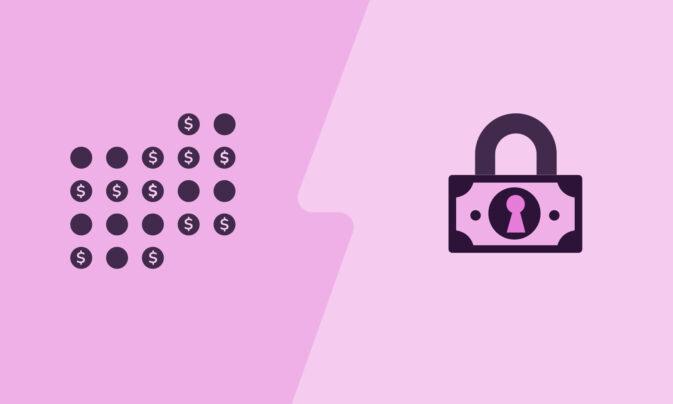Are you tired of constantly struggling to increase your agency’s profit margins?
You’re not alone. And while that might sound comforting, agency profitability shouldn’t feel like solving a mystery without clues.
Yet, for many agency owners, profit margins can feel like a riddle wrapped in a spreadsheet. The good news? Cracking the code isn’t as complicated as it seems — once you know what to look for.
This guide is your roadmap to running a leaner, more profitable agency. We’ll show you:
- The financial metrics that actually matter (and why most are just noise)
- How to track them without losing your sanity
- Three profit-boosting levers you can pull right now
No fluff, no jargon — just actionable insights to help you take control of your bottom line.
The content in this blog post was covered in a Toggl Academy webinar with Marcel Petitpas.
He’s an agency profitability expert and owner of Parakeeto, which helps high-growth creative agencies, consultancies, and service businesses track the right metrics and maximize their profitability.
Watch the entire webinar now. 📺

Core financials to track
Before we get too far into the “how” and “why” of things, let’s run through the numbers you should be seeing on your profit and loss statement (P&L):
- Total revenue: Total income generated from all client activities or a single project
- Agency Gross Income (AGI): Total revenue generated from clients or a project minus pass-through expenses
- Delivery profit: AGI minus your delivery costs
- Delivery margin: The percentage of profit generated from client work.
- Overhead: Business cost (marketing, accounting, office expenses, etc.)
- Total net profit: Income left over after subtracting all delivery costs and overhead
We’ll briefly explain each metric below and then run through how to track or calculate each one accurately.
Total revenue
The obvious metric all businesses should be tracking. Total revenue, or income. If you do not see that on your financial statements, you have bigger problems.
How is it calculated? Pretty straightforward here. All income generated from client activities.
If you have properly set up your accounting software dashboard, it will provide you with the most precise view of this metric.
Agency Gross Income
Agency Gross Income (AGI) is the total income generated from client activities minus pass-through expenses.
What are pass-through expenses?
Pass-through expenses are essentially the money that comes into your agency that doesn’t belong to you.
It’s “passing through” other vendors.
Examples include:
- Your client gives you money to spend on ads on platforms such as Google, Facebook, Linkedin, etc.
- You’re a web development agency that tends to buy website templates and stock photos.
- You work with white-label partners or freelancers on client projects from time to time.
The formula to calculate AGI looks like this:
AGI = total income – pass through expenses
For example, the AGI for Agency X for one month may look like this:
| Total revenue | Pass-through expenses | AGI |
|---|---|---|
| $100,000 | $20,000 | $80,000 |
Regarding project work, you can consider AGI to be the fixed fee you charge a client and the project budget you must manage throughout the project’s lifecycle.
Calculating your pass-through expenses as part of your project cost estimation process would be best.
How do you know what pass-through expenses to consider?
-
- Fully scope out the project/work and collect all project requirements
- Break down the project into smaller chunks using a Work Breakdown Structure (WBS) to understand what resources you’ll need.
- Create your project cost estimate based on your WBS
- Establish and manage your project budget
Delivery profit
Delivery profit is the revenue (profit) left over after you have deducted your delivery costs from your AGI.
The formula to calculate your delivery profit looks like this:
Delivery profit = AGI – delivery costs
But what are delivery costs?
Delivery costs are the total cost of getting the work done for a client.
This will generally be labor costs (payroll).
Suppose you have a team of designers, project managers, developers, strategists, copywriters, and creative directors. In that case, those are all people whose payroll is most likely entirely or almost wholly allocated to delivery.
How do you calculate delivery costs?
First, you’ll need to determine each person’s true labor cost, or Fully Loaded Cost (FLC), to determine how much they cost you per hour in labor.
An employee’s FLC is that person’s annual salary plus any additional burden costs.
A basic FLC formula looks like this:
Fully Loaded Cost = Yearly Salary + Benefits + Training & Tools
For example, say you pay your employee Emma $100,000 per year; she has $7,000 worth of benefits and $3,000 worth of equipment — her FLC may look like this:
| Expense | Cost |
|---|---|
| Salary | $110,000 |
| Benefits | $7,000 |
| Training and tools | $3,000 |
| Fully Loaded Cost | $120,000 |
Once you know an employees FLC, you can quickly work out their labor cost per hour, aka Average Cost Per Hour (ACPH).
ACPH = Fully Loaded Cost / 2,080 hours
Note: you can use 2080 working hours yearly for salary calculations. When working full-time at a standard 8 hours per day, five days a week, you get 40 hours per week.
Emma’s ACPH would be $57.69 per hour.
The ACPH for each employee is what you should use to calculate your total delivery costs per project/client to allow you to calculate your delivery profit accurately.
Continuing from the example above, Agecny X’s delivery profit for the month may look like this:
| Total revenue | Pass-through expenses | AGI | Delivery costs | Delivery profit |
|---|---|---|---|---|
| $100,000 | $20,000 | $80,000 | $30,000 | $50,000 |
Delivery margin
Delivery margin is the percentage of delivery profit generated from client work.
The formula to calculate your delivery margin looks like this:
Delivery margin = (AGI – delivery costs) / AGI)
Using the data from above, the delivery margin for Agency X for the month would be 62.5%.
| AGI | Delivery costs | Delivery profit | Delivery margin |
|---|---|---|---|
| $80,000 | $30,000 | $50,000 | 62.5% |
What’s a good delivery margin?
Marcel of Parakeeto recommends aiming for a 55% delivery margin on your P&L and a 70% delivery margin on projects. If you can achieve this, you’re likely to be very profitable.
But why the difference?
A healthy net profit target for an agency is 25%.
With the average spend on overhead sitting at around 30%.
This gives you a minimum delivery margin of 55% to hit that net profit goal.
The general rule is to add 10-20% to your profit and loss target on a per-project or per-client level to compensate for gaps in utilization, projects that go off the rails, shared delivery costs, etc.
So we’re adding a 15% buffer to the 55% delivery margin target, which gives you a 70% delivery margin target for projects.
Marcel and Parakeeto work with many agencies, and the simple rule they tend to advise is to aim for a 50%+ delivery margin on your P&L and 70%+ on projects.
Note: we’ll dive into how to achieve a 70% delivery margin in the ‘How to maximize your profits‘ section below. 📈
Business overhead
Business overheads are the cost of running your business.
This may include:
- The marketing budget for ads
- Monthly or annual accounting fees
- Office equipment for employees
- Lawyer fees
- Office rent
- Etc.
How do you calculate this?
You’ll have to put each expense into a spreadsheet to calculate this (or maybe you’re already tracking them in your accounting software). Most business expenses will be monthly, so start with your monthly invoices.
Don’t have a spreadsheet to hand?
You can use our free profit and loss statement template below to list your overhead and expenses.

Note: we’ll run through how best to use this template in the next section, ‘Tracking your core financials‘.
Total net profit
The magic number and key metric all agencies need to know.
Total net profit = delivery profit – overhead costs
Keeping with the examples we’ve been using above, Agecny X’s total net profit for the month may look like this:
| AGI | Delivery costs | Delivery profit | Overhead costs | Net profit |
|---|---|---|---|---|
| $80,000 | $30,000 | $50,000 | $20,000 | $30,000 |
You want your overhead costs to be 20-30% of your AGI. So if you generated $10,000 in AGI for the month, you should have less than $3,000 in overhead costs.
Hopefully, you now understand what core financials you should track in your agency.
Let’s recap each metric:
- Total revenue – total income generated from all client activities or a single project
- Agency Gross Income (AGI) – total revenue generated from clients or a project minus pass-through expenses
- Delivery profit – AGI minus your delivery costs
- Delivery margin – the percentage of profit generated from client work — aim for 55% on your P&L and 70% on projects
- Overhead – business cost (marketing, accounting, office expenses, etc.) — aim for 20-30% of your AGI
- Total net profit – income left over after subtracting all delivery costs and overhead — aim for a target of 25%
But how do you best calculate and track each one?
Let’s take a look.
Tracking your core financials
Total revenue
You may track this on a spreadsheet, or for more accuracy, through accounting software.
If you have the data, use our P&L template below to understand better and track your core financials.
Note: the template automatically calculates your AGI, delivery profit, delivery profit %, overhead cost %, and total net profit. We’ll explore each section of the template throughout the sections below.
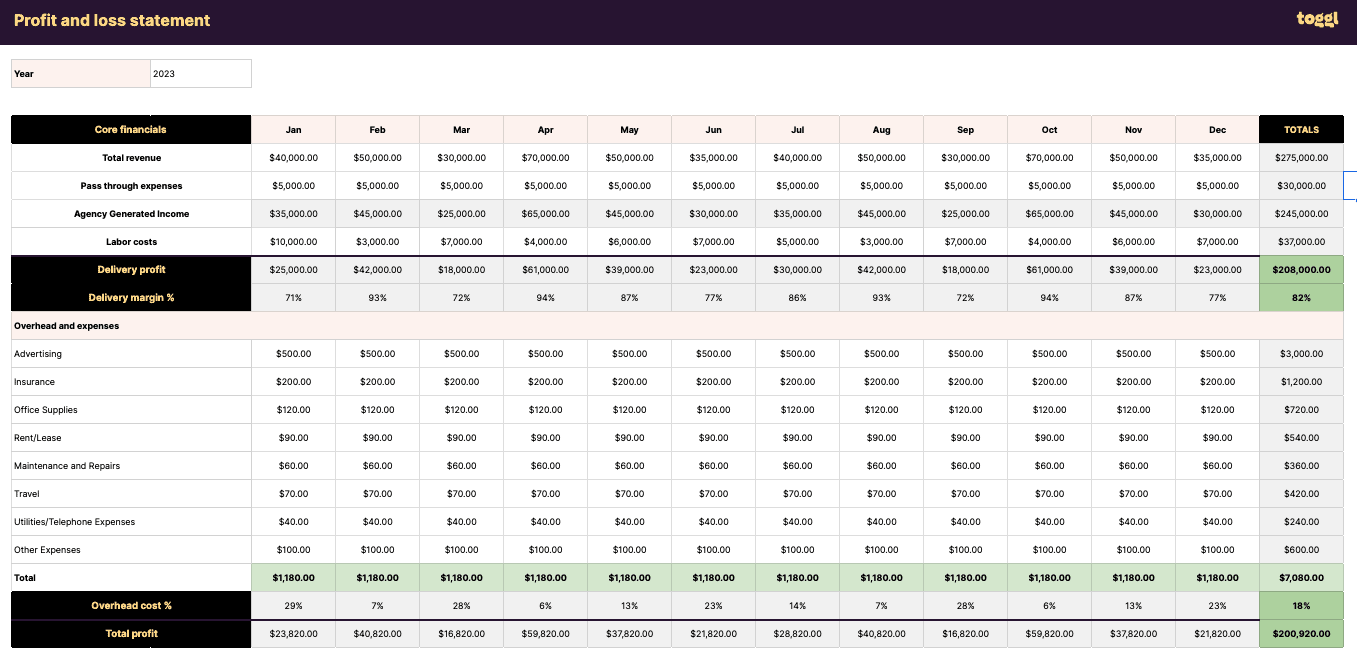
Agency Gross Income (AGI)
AGI is the total revenue generated from clients or projects minus pass-through expenses.
Examples of pass-through expenses we went through above include:
- Your client gives you money to spend on ads on platforms such as Google, Facebook, Linkedin, etc.
- You’re a web development agency that tends to buy website templates and stock photos.
- You work with white-label partners or freelancers on client projects from time to time.
Remember, calculating pass-through expenses for each project as part of your cost estimation process is best.
Regarding project work, you can consider AGI the fixed fee you charge a client and the project budget you’ll monitor closely.
Once you’ve calculated the total cost of delivering the project, you can track the project budget (minus the pass-through expenses) using a project time tracking spreadsheet or a tool like Toggl Track.

You can monitor the budget using the Project Dashboard to track the total and billable hours worked (aka your delivery costs 😉).
You will also see a trendline that predicts billable amounts tracked in the future based on historical time tracking data for the project you are viewing.
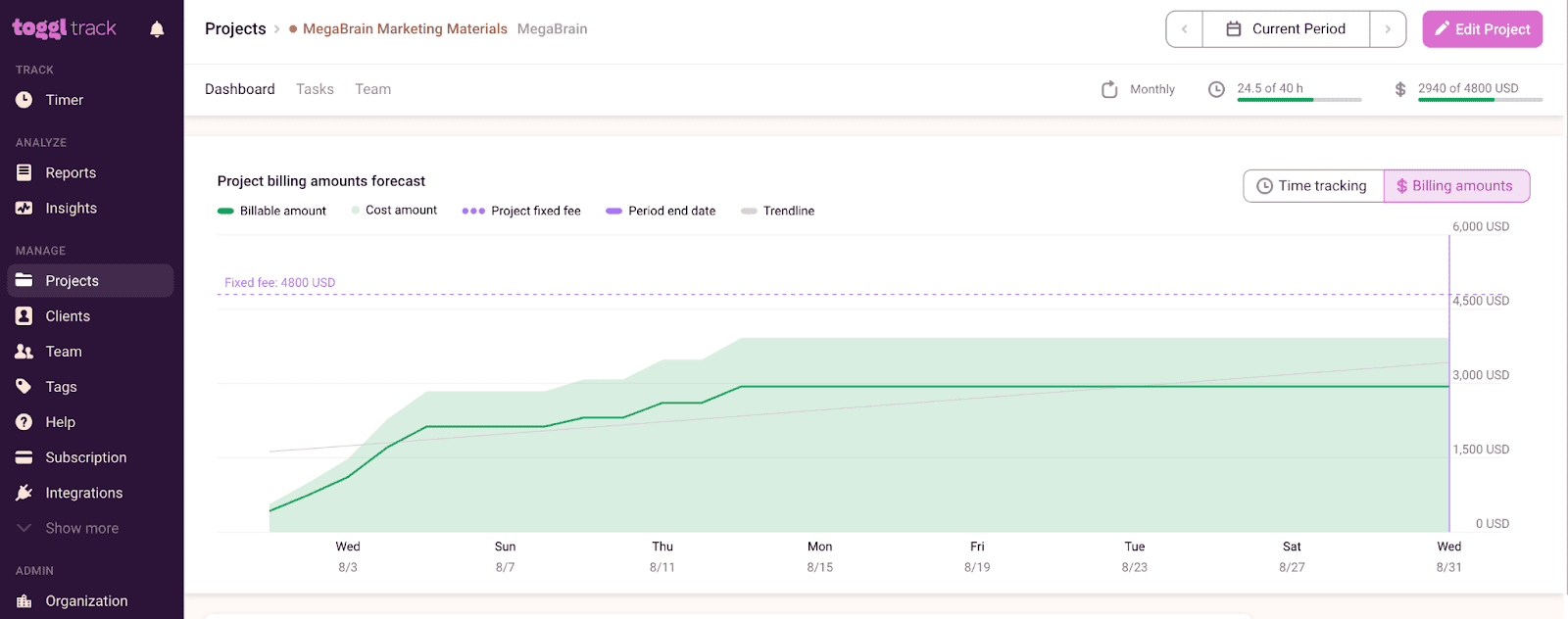
You can plug your total revenue, pass-through expenses, and labor/delivery costs into our P&L template.
You can do this for each month to calculate your annual figures:

Or for a single project using the ‘project profit and loss’ tab:

Adding this data will automatically calculate your delivery profit and margin.
Delivery profit
Let’s remind ourselves of the delivery profit formula:
Delivery profit = AGI – delivery costs
Remember, delivery costs are your teams total labor costs or ACPH.
To calculate ACPH, you need to calculate the Fully Loaded Cost of each employee.
Fully Loaded Cost = Yearly Salary + Benefits + Training & Tools
And then calculate their ACPH.
ACPH = Fully Loaded Cost / 2,080 hours
You need to track labor/ACPH for each employee to understand each project/client’s profitability. You can add the ACPH for each team member via workspace settings inside Toggl Track.

Every time an employee tracks time spent on a project, their labor costs are automatically calculated inside the Insights Dashboard to give you the total labor/delivery cost per project.
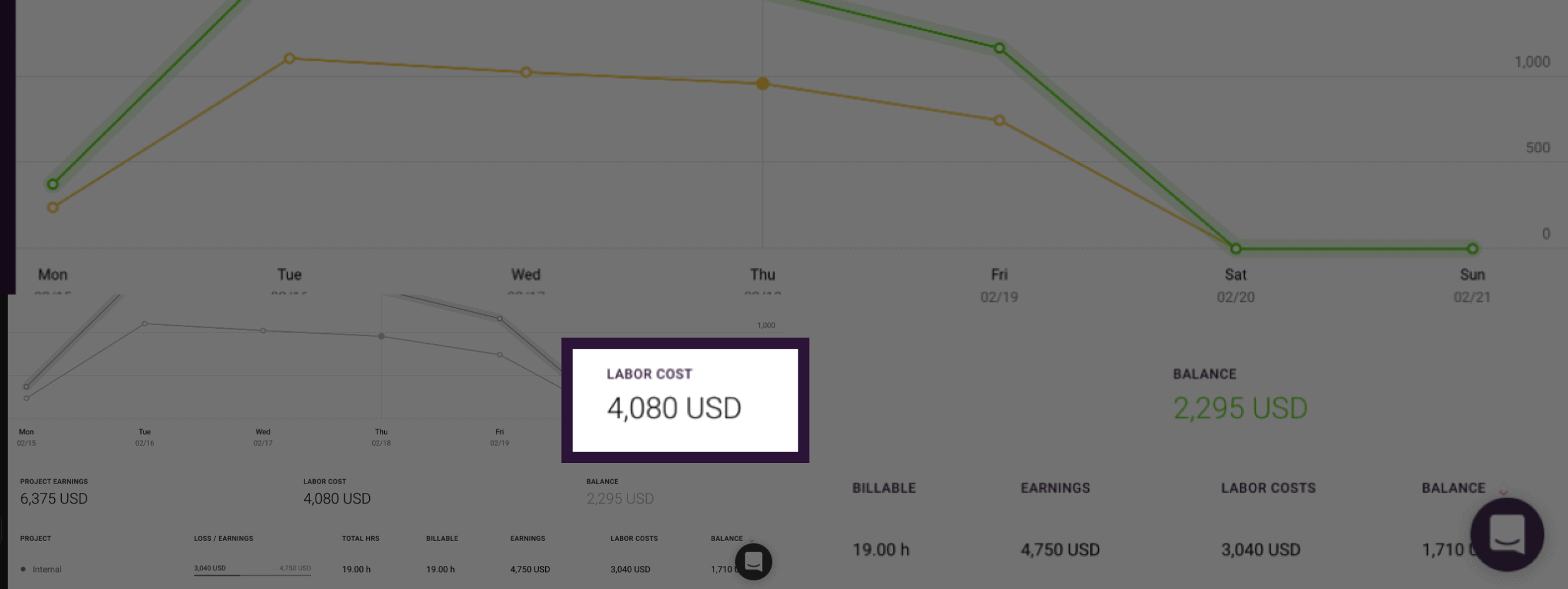
This will give you your “balance” (your delivery profit).
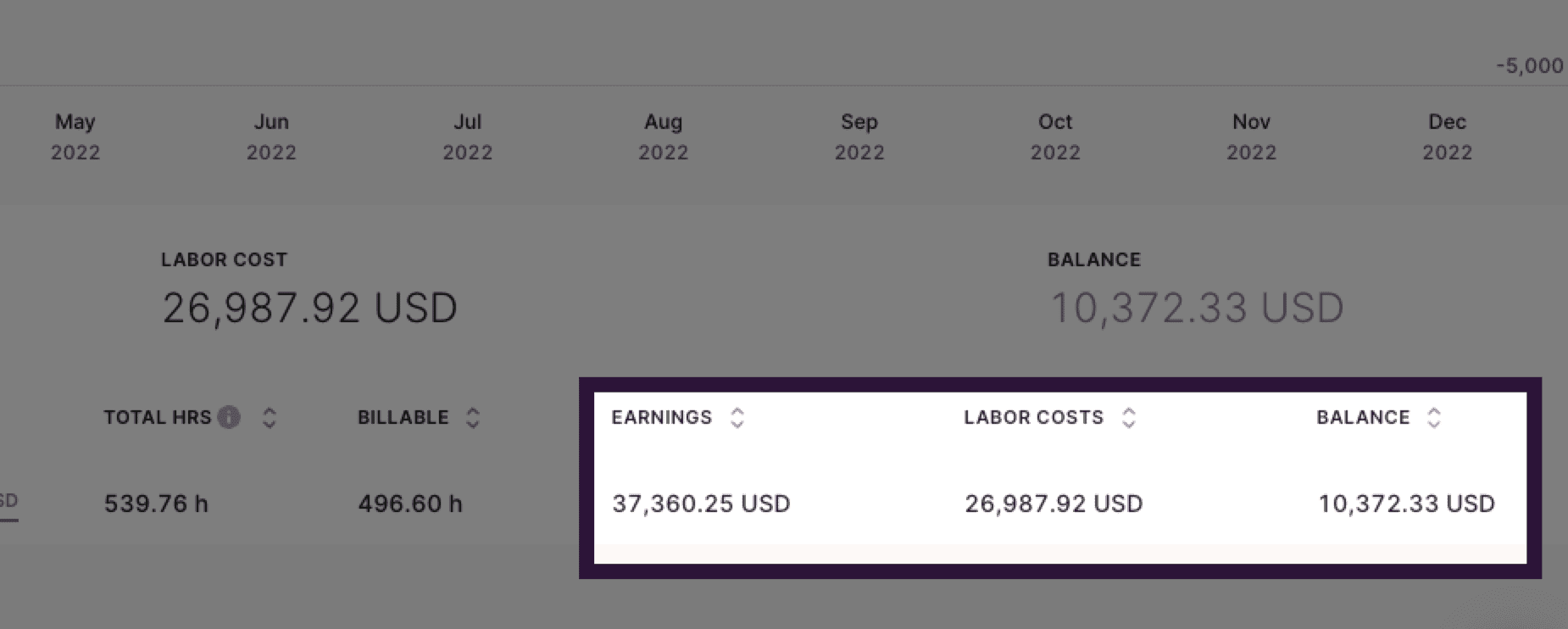
You can plug your monthly labor/delivery costs into our P&L template to calculate your delivery profit automatically.
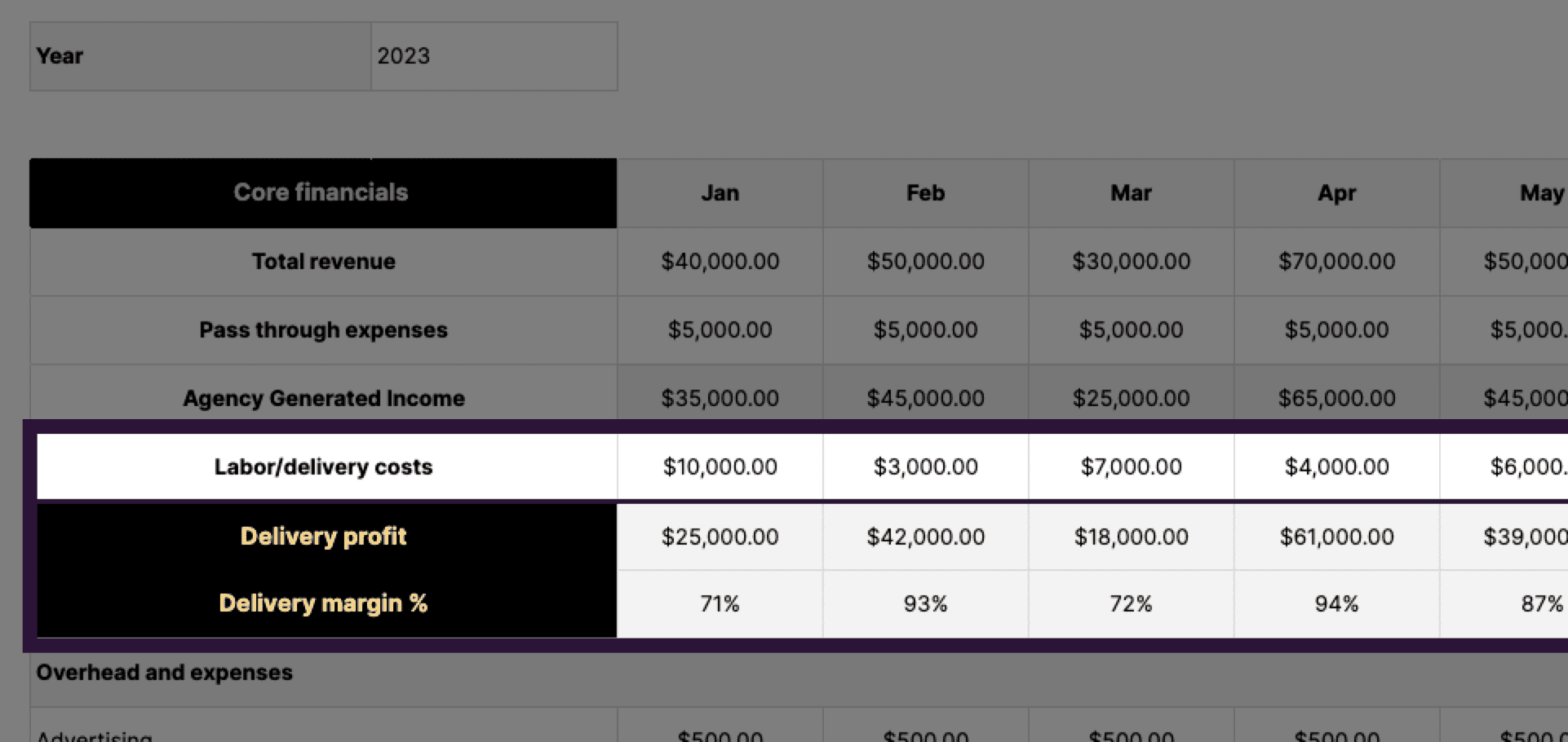
Delivery margin
Take your AGI and deduct your total labor/delivery costs to calculate your delivery margin.
Here’s a reminder of the formula:
Delivery margin = (AGI – delivery costs) / AGI)
For example, let’s say the fixed fee for ‘Project X’ was billed to the client at $10,000, had $1,000 in pass-through expenses, and cost you £3,500 to delivery it.
It would have a delivery margin of 67% (not far off the 70% target).
| Total revenue | Pass-through expenses | AGI | Labor costs | Delivery margin |
|---|---|---|---|---|
| $10,000 | $1,000 | $9,000 | $3,000 | 67% |
Keeping track of your labor/delivery costs with a time tracking tool is the only way to calculate an accurate delivery margin.
Tracking this data will help you understand each project’s true profit. It will also help you to make informed decisions about pricing and other aspects of your business.
You can use our P&L template to calculate your monthly or per-project delivery margin percentage if you have the data.

Overhead and expenses
Overhead and expenses can include the following:
- Advertising for your agency
- Insurance costs
- Office Supplies
- Rent
- Maintenance
- Utilities
You may be tracking this on a spreadsheet or through your accounting software. If not, add your overhead costs to our P&L template.
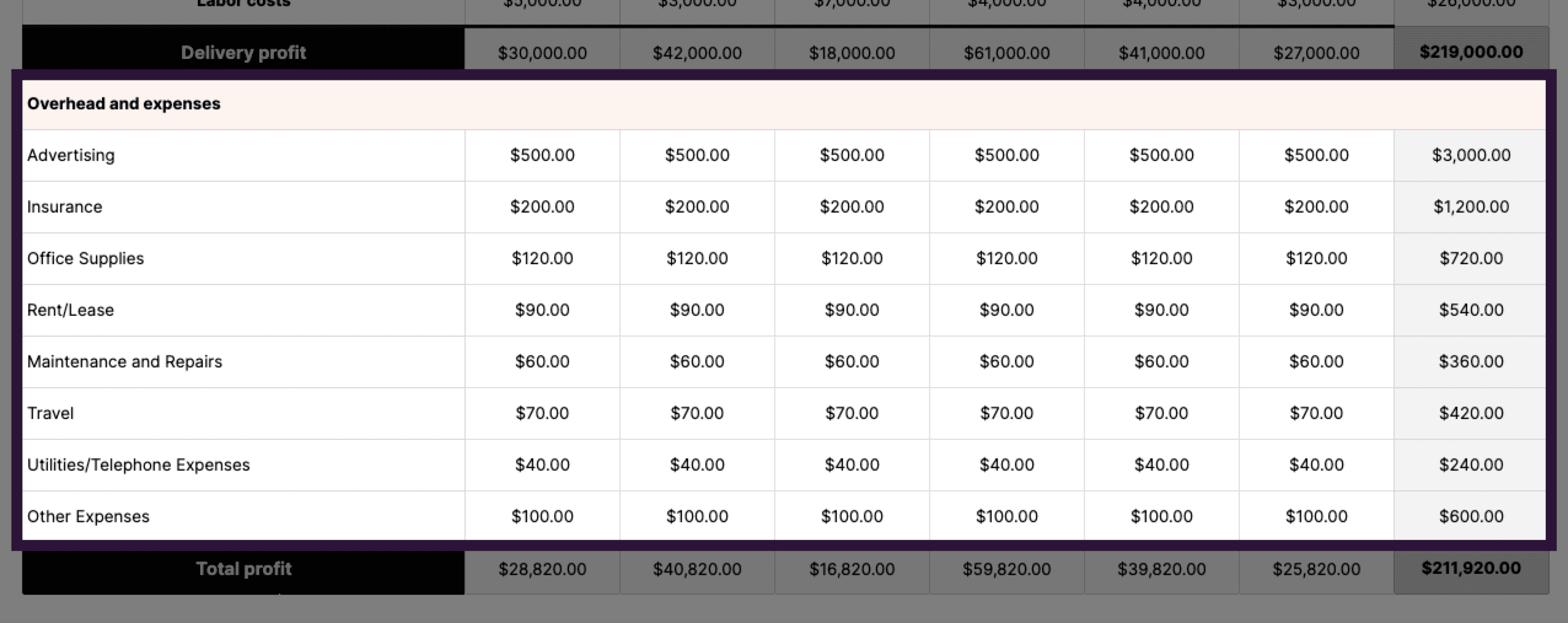
Doing so will help you to calculate your total net profit.
Total net profit
Now, if you’re tracking all core financials accurately, this is a metric you can work out quite quickly.
A reminder of the formula for total net profit:
Total net profit = delivery profit – overhead costs
If you’re using our P&L template, you may start to have something that looks like this:

We have added rows to calculate your:
- Total net profit
- Total net profit percentage (target of 25%)
- Overhead cost percentage (aim for 20-30%)
Hopefully, you now know how to calculate your true net profit accurately.
But what can you do to increase it?
Let’s take a look!
How to maximize your profits
Out of all the core financials you should be tracking, your delivery margin is the one to focus on to maximize your profits.
The three levers you can play with to influence your delivery margin are:
- Average Cost Per Hour (ACPH)
- Average Billable Rate (ABR)
- Employee Utilization Rate
Average Cost Per Hour (ACPH)
The first step in improving your delivery margin is decreasing labor/delivery costs.
The best way to do this is to decrease the Average Billable Rate (ABR) of a project by looking at how much it costs to deliver it.
ABR is calculated by dividing the total revenue generated from a project (AGI) by delivery hours.
ABR = AGI / delivery hours
Note: delivery hours are any time spent on client work, regardless of whether or not a client was billed for it
Now let’s look at what the Average Billable Rate (ABR) would need to be for two employees to hit the target of 70% delivery margin on a project.
| Project | FLC | Capacity | ACPH | Target ABR |
|---|---|---|---|---|
| Emma | $120,000 | 2080 | $57.69 | $192.30 |
| Intern | $50,000 | 2080 | $26.44 | $88.13 |
| Total | $175,000 | 4080 | $42.89 | $142.97 |
The target ABR is calculated by dividing ACPH by one minus the delivery margin target (70%).
The formula looks like this:
ABR target = ACPH / (1 – 0.7)
Say you wanted to target a 60% delivery margin; you’d switch out the 0.7 in the formula above to 0.6, giving you 0.4 — giving you a target ABR of $144.25.
But if we want to achieve a 70% delivery margin on a project with Emma working 100% of the time on it, we’d need to charge an ABR of $192.30
70% ABR target = $57.69 / 0.3
An intern doing 100% of the work would result in an ABR of $88.13
But if you got an intern to complete 50% of the project, we’d only need an ABR of $142.97 to achieve a 70% delivery margin.
This makes the amount of AGI required per project or client much more forgiving.
Check out Marcel explaining this entire process in a recent Toggl Academy video.
However, we must be honest here; increasing your delivery margin by lowering your delivery costs is simple in theory but harder to do in practice.
There are a few options here:
- Get team members with a lower ACPH to deliver most of the project (as shown in the example above)
- Hire external contractors with a lower ACPH than your team to do the work
- Create Standard Operating Procedures (SOPs) so your team is more efficient with their hours
What is your best option?
Focus on improving your internal processes by creating SOPs so that you can use team members with a lower ACPH to deliver the bulk of the work.
This is something a lot of successful agencies are now prioritizing.
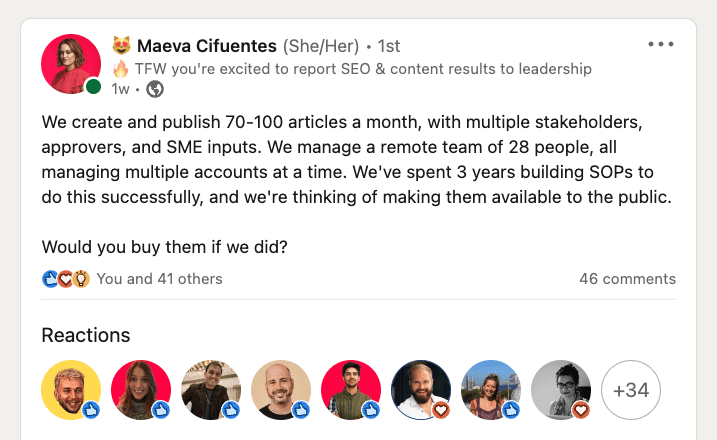
Average Billable Rate
Increasing your teams ABR is the answer to getting your team to produce more revenue from the same number of hours worked.
The ABR formula looks like this.
ABR = AGI / hours worked (billable and non-billable)
For example, say you charge $15,000 for a single project, and your team spends 200 hours working on it. The ABR would be $75.
The great thing about using ABR as a metric to track is that you can look at it per project to understand what type of work makes you the most revenue.
Let’s use the table below to illustrate how this works:
| Project | Revenue | AGI | Delivery hours | ABR |
|---|---|---|---|---|
| Website build | $70,000 | $50,000 | 500 | $100 |
| Brand design | $20,000 | $15,000 | 100 | $150 |
| Funnel build | $30,000 | $10,000 | 50 | $200 |
| Total | $120,000 | $75,000 | 650 | $115 |
The website build is the biggest revenue generator on the surface, but it had $20,000 in pass-through costs, so it’s more of a $50,000 project.
It took 500 hours to get over the line, which left an ABR of $100.
But take a look at the funnel build project…
It had $20,000 in pass-through costs, too. But most of the work was outsourced or passed to a junior team member.
This produced an ABR of $200. 🤑
Knowing the ABR of each project, task, or client is a great way to get insights into:
- What clients to cut or retain
- What clients to go after in the future
The best way to calculate ABR is to track the total hours spent on client work.
Remember, the ABR formula looks like this:
ABR = AGI / hours worked (billable and non-billable)
Using Toggl Track, you can enter the fixed fee (AGI) for each project and then track your teams time against it. The Insights Dashboard lets you easily view the total hours worked on each project.

You can easily export this data and use our ABR calculator template to work out the ABR for each project quickly.

Note: paste your Toggl Track data into the ‘Raw data’ tab. You will have to enter the fixed fee for each project — this will then calculate the ABR. You can also use Toggl Track data to calculate the ABR at client and task levels.
Improving the ABR rate of a project can be done by:
- Reducing the total number of delivery hours by making your team as efficient as possible with SOPs
- Creating more accurate project cost estimates during the discovery phase
- Better managing project costs using tools to track expenses
- Delivering the project using people with a low ACPH
- Upping how much you charge per project
But only up your rates once you have nailed your internal processes (how you scope, price, execute, and manage projects).
Fixed fee, or flat rate, pricing is perfect for project work as it sets you up for more income and growth. A flat-rate project rewards you for being efficient. The faster you can complete a project, the more profit you make. So the more experienced you become, the more you get paid.
Check out our guide ‘Flat Rate vs. Hourly‘ to learn more.
Knowing the ABR of each project, task, or client is also crucial if you’re trying to make decisions on:
- What clients to get rid of
- What clients to fight for and retain
- What type of work to go after in the future
However, be aware that a low ABR for a project may also indicate a lack of understanding and confusion from your team when working on a project.
For example, take the ‘Website Content Change’ project in the image above. It has an ABR of $44.44 — which is incredibly low compared to other projects.
Why?
One potential scenario is that:
- The project requirements were not fully understood
- This created an inaccurate project cost and time estimate
- Resulting in more time spent on the project than initially estimated
- Which caused the project to be stressful/confusing for your team — resulting in a low ABR
You can use ACPH and ABR to get a quick understanding of your delivery margin. Say you have a blended ABR of $150 and ACPH of $60 for a particular month, you’d have a estimated delivery margin of 60% — close to the 70% target!
The basic formula for an estimated delivery margin = (ABR-ACPH) / ABR
Employee Utilization Rate
Employee utilization rate is a misunderstood metric in the agency space as it’s often overcomplicated.
It’s simply the percentage of hours you pay for, through your employee salaries, that is being used to generate profit for your business (client work).
Employee utilization rate = (delivery hours / capacity)
Note: delivery hours in this formula are billable and non-billable hours combined.
Here’s an employee utilization rate for a team of two for one week, with 20 delivery hours each.
| Delivery hours | Capacity | Utilization rate |
|---|---|---|
| 40 | 80 | 50% |
Figuring out your employee utilization rate helps you to understand:
- If you’ve got enough client work for your team to do.
- If you’re asking your team to spend too much time on administrative/non-billable tasks.
- If you’re working your team too hard/need to hire.
But what’s a good utilization rate?
Marcel suggests aiming between 85 and 90% (32-36 out of 40 hours per week).
But some roles, like team leaders or project managers, may be busy with client work 50-75 % of the time (20-30 hours a week). But in certain situations, such as a developer working non-stop on a software project for six months, they could be at a 95-100% rate.
It’s important to point out that calculating employee utilization should include the total capacity of all your team.
This includes all hours from all your employees:
- All billable staff
- All non-billable staff
- All paid time off
Why?
If you don’t, the metric will make you think you’re more profitable than you are.
For example, say your employee Emma gives you, on average, 30 delivery hours per week annually — with her weekly capacity hours being 40 hours.
And say she has 25 vacation days per year, giving her an average weekly capacity of 36 hours.
Now look at how this impacts her utilization rate.
| Delivery hours | Capacity hours | Utilization |
|---|---|---|
| 30 | 40 (vacation included) | 87.5% |
| 30 | 36 (vacation removed) | 96.8% |
A utilization rate of 96.8% looks incredible, but it’s sadly not a reality.
By removing vacation time when calculating employee utilization, it appears that your team is spending most of their time on client work (generating revenue), giving you the impression that you’re more profitable than you are.
The best way to calculate your employee utilization is to get your team to track their time spent on all client work. Using a tool like Toggl Track, you and your team can easily track time spent on billable and non-billable work.
The Reports Dashboard will give you all the information you need to understand better how well your team is working — including total hours worked, billable hours, and revenue generated.

You can then export this data to better understand your teams utilization rate.
Use the Weekly Report in Toggl Track to get the data you need.
- Use the date picker to select the time period
- Export this data via the download button

Note: we recommend looking at monthly employee utilization rates for more accurate percentages.
But how do you increase your employee utilization rate?
You have two options:
- Increase your delivery hours
- Lay off some staff (try to avoid this!)
1. Increase your delivery hours
Increasing the number of delivery hours should be your first step to improving your overall employee utilization rate.
How? By bringing in more client work.
More clients = more delivery hours = more profit for you.
But increasing the number of delivery hours doesn’t necessarily mean you will generate more profit — getting your team to generate more revenue with the hours they’re working does.
Marcel gives an excellent example of how getting your team to hit an employee utilization target can backfire.
This is why it’s important to consider another utilization metric: delivery utilization.
This is the percentage of billable hours (revenue) within your team’s total delivery hours. The higher this number is, the more revenue your team will generate per project/client.
You can easily find this metric in Toggl Track via the Reports Dashboard.

This metric is more of a project management metric. In contrast, employee utilization is more of a higher-level metric that helps you understand how much profit you’re generating from the time you’re buying in bulk (employee salaries).
But what do you do first?
Here are a couple of steps you can take to make sure you’re maximizing profits when it comes to utilization:
- Analyze your delivery utilization per project to maximize project profitability
- And then dig into your employee utilization rates to maximize your team’s time
Doing this will ensure your team and projects are both as profitable as possible.
How do you improve delivery utilization? Most of the steps you can take involve the work you do before the project starts.
Similar to the other two levers, this can be done by:
- Fully understanding project requirements
- To help you create accurate cost estimates and time estimates
- Allowing you to manage project costs better
- And using tools to track project costs accurately
All of which will help you to maximize project profitability.
How healthy are your margins?
Understanding and improving your net profit is essential for maintaining a healthy and sustainable agency. By tracking and calculating core financials, you can identify areas for improvement and implement effective strategies to maximize your profitability.
Check out the guides below to learn more about how to build a sustainable, profitable agency (they’re all full of tips and plays from other agency owners just like you):
- Mastering Agency Management for Higher Profits
- Track What Matters: The Ultimate Agency Metrics Playbook for Profitability
- Building Agency Operations to Scale: A Guide to Profitable and Efficient Workflows
- Future-Proof Your Agency with Smarter Project Planning
- Retention or Burnout? A Modern Guide to Smarter Workload Management
- Billable Utilization: Formulas and Strategies for Increased Profitability
Sean is a Content Marketer at Toggl. He's been involved in SEO and Content Marketing since 2017. Before working for Toggl, Sean ran SEO at a digital marketing agency—so he's all too familiar with time tracking and project management.






